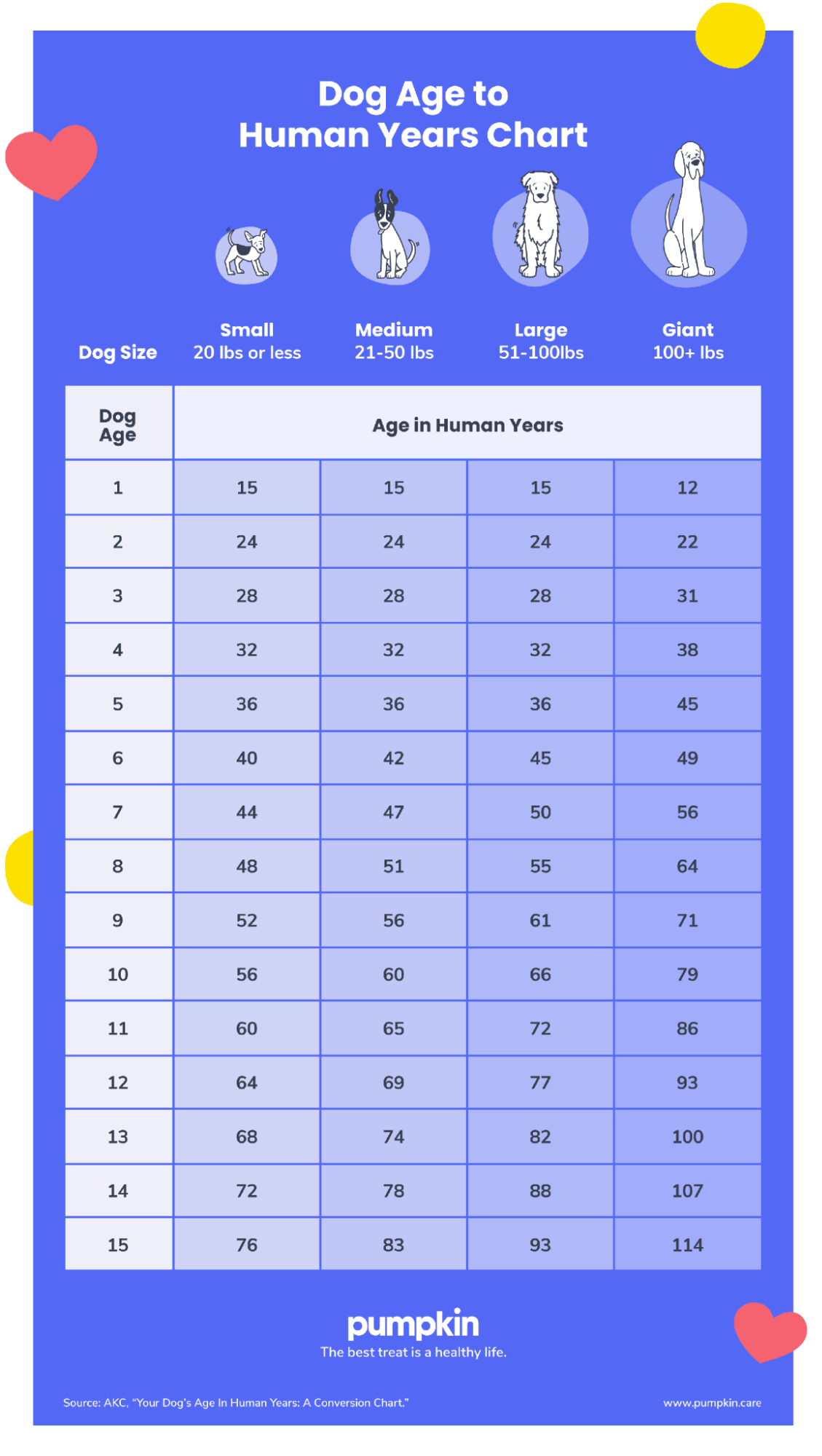- Randa Kriss
- Oct 22, 2024
- 7 min read
Updated: Aug 1
Key Points
The old adage “one dog year equals seven human years” isn’t accurate.
A more precise (and complicated) formula can show you how old your dog really is in dog years. You can also use the Pumpkin dog years to human years calculator below.
A dog’s “human age” is also affected by their breed and size.
It’s common knowledge that one year of a dog’s life equals seven human years, but you can’t always trust common knowledge. If this is the way you’ve been calculating your dog’s age, you’re not alone.
While this simple calculation method has been around for decades, it doesn't reflect the complexity of canine aging. In reality, dogs age faster than humans in their early years, but their aging process slows down in later years. (The same goes for the family cat.)
Recently, researchers developed a more precise method of calculating dog years to human years, and we built a calculator using this formula to take the guesswork out of determining your dog's true age.
How do I calculate my dog’s age in dog years?
To calculate dog years, you can use the new formula created by researchers at the University of California San Diego School of Medicine. These researchers studied how human and dog DNA changes over time by looking at patterns called methyl groups in humans and Labrador Retrievers. They found that dogs grow and develop much faster when they’re young — that’s why the 1:7 ratio is so inaccurate.
This research concluded that you can calculate human years to dog years by multiplying the natural logarithm of the dog’s age by 16 and adding 31. Their formula looks like this: (human_age = 16ln(dog_age) + 31).
If this formula feels a bit too complex, you can plug your dog’s age into an automatic dog age calculator.
Dog age calculator chart
There are now multiple methods for determining your dog's true age. Because small dogs age more slowly, your dog's size and weight also influence the calculation. You can use our dog years to human years chart to calculate your pup's age based on their size.

Why is this information so important? When you have an accurate idea of your dog’s age, you can better tailor their diet and exercise levels to their stage in life, whether they’re a puppy, adult, or senior dog.
The simplified method
There’s one more method to estimate your dog’s age. You can follow this methodology from the American Veterinary Medical Association (AVMA). This method is based on medium-sized dogs weighing 21-50 pounds, and so it doesn't take into account how size and breed affect aging.
This method has been making the rounds on the internet for years, but you should take it with a grain of salt. We reached out to the AVMA, and a representative confirmed that this method is based on an old resource that has since been removed from the AVMA website.
The first year of a dog’s life is equal to 15 human years.
The second year of a dog’s life adds about 9 human years.
Each additional year adds about 4 to 6 human years.
Again, it’s important to note that not all dog breeds age the same way. In general, larger dogs tend to have shorter lifespans than smaller dogs, so while a 7-year-old Great Dane might be considered a senior dog, the same isn’t necessarily true for a 7-year-old Chihuahua.
How do dogs age differently?
Every dog ages differently, just like humans. Both biological and environmental factors can impact their aging process and lifespan.

Size
Your dog's size and weight have a big impact on their age in dog years. Larger dogs age much faster in comparison to small- and medium-sized dogs. By 7 years old, a small dog, like a Dachshund will be 6 human years younger than a large breed, like an Airedale Terrier.
Ultimately, scientists aren’t completely sure why smaller dogs age slower and live longer than larger ones.
Some researchers hypothesize that it’s because larger dogs are affected by age-related diseases more quickly. It’s possible that because larger dogs progress from puppyhood to adulthood much faster, abnormal cell growth, cancer, and other diseases are more likely.
Breed
Certain breeds are predisposed to health issues that can affect their aging process.
For example, Pugs experience breathing difficulties due to their flattened facial features. Hip dysplasia is common in German Shepards, while Cocker Spaniels are more likely to have eye problems.
Just as some breeds are prone to certain issues, others can thank their genes for their longevity. Chihuahuas, for instance, are known for their long lifespan, living well into their teens or even twenties.
Lifestyle
While nature has a big say in how your dog ages, lifestyle can significantly affect their health and aging process, too.
Giving your dog a balanced and appropriate diet prevents obesity, which is often the culprit behind diabetes, heart disease, and joint problems. Adequate exercise also keeps their muscles and joints strong.
Moreover, spaying or neutering your dog can help prevent certain types of cancer and life-threatening infections.
What are common signs of aging in dogs?
You can also pay attention to physical and behavioral clues to gauge your dog’s age.
For instance, according to the Humane Society of the United States, by 7 months, your dog will have all their permanent teeth. By 1 to 2 years old, their teeth may appear duller and slightly yellowed. By 5 to 10 years, expect visible dental wear and tear.
Indicators that your dog is reaching the senior stage include:
Graying hair
Poor eyesight or cloudy eyes
Trouble hearing
Stiff muscles and joints or arthritis
Lower activity level
Behavioral changes (anxiety, confusion, accidents in the house, irritability, etc.)
Larger dogs may show signs of aging around 5 or 6 years old, while small or toy breeds might not have noticeable changes until 7 or 8 years. If you’re unsure, you can always ask your veterinarian for an accurate estimate of your dog’s age in dog years.

Tips to help your dog live longer
While forever may not be possible, there are ways to help your dog live a longer and happier life. Remember, by understanding how breed, size, and lifestyle influence aging in dogs, you can tailor their care to meet their needs at every life stage.
1. Have regular veterinary checkups
Scheduling regular check-ups at the vet is important for so many reasons. For serious illnesses, early detection often increases the chances of successful treatment. Moreover, routine vaccinations, parasite prevention, and screenings all help prolong your dog’s life.
While regular wellness visits are important, it's the unexpected vet bills that really bite. A pet insurance policy can give you financial and mental peace of mind by covering unexpected, and often expensive, veterinary care in the future. This way, you can get your pup the care they need.
2. Maintain a healthy weight
Obesity is a common problem in older pups. It puts extra stress on joints, bones, and organs and can lead to serious health problems like pancreatitis or diabetes. It’s hard to resist those pleading eyes, but portion control and limited treats can prevent your dog from excessive weight gain.
3. Provide enough exercise time
Exercise not only helps your dog maintain muscle mass but also helps them release pent-up energy. It's a natural way to reduce stress and anxiety. Remember to change the intensity and duration of exercise based on your dog's age and health.
4. Stimulate them mentally
Just like humans, dogs can experience cognitive decline as they age. Boredom and lack of mental stimulation can also lead to stress and anxiety in dogs. Puzzle toys, interactive feeders, and training exercises are all smart ways to challenge your dog's mind. Not to mention, they let you bond with your dog while keeping their minds sharp.
Dog years to human years: A fresh look
Now that the "one dog year equals seven human years" myth has been debunked, the next time someone asks you, "How old is your dog in human years?", you'll have a chance to share your dog age expertise.
But age is, after all, nothing but a number. Taking care of your pet’s health and enjoying a happy life with them are the true keys to canine longevity. After all, whether your dog is 7 or 70 in human years, they still need love, attention, and plenty of belly rubs to live a long and happy life.
Dogs of all ages encounter unexpected accidents and illnesses from time to time. With Pumpkin Dog Insurance plans, you have the option to get 90% cash back on eligible vet bills — fetch a free quote today!
FAQs about dog years
Is a 1-year-old dog still a puppy?
Puppies become adult dogs between 1 and 2 years old. However, they can still have some puppy characteristics, like bursts of energy and excessive chewing, as adult dogs. Aging in dogs also varies from pup to pup, depending on size, breed, and socialization.
At what age do dogs stop growing?
Dogs typically stop growing between 6 and 24 months. But this also depends on breed, sex, genes, and diet. Smaller breeds can stop growing when they reach 6 to 8 months. Medium breeds take roughly 12 months, and larger breeds take about 12 to 18 months. As for giant breeds, like mastiffs, it may take 2 years for them to reach full size.
What is the ratio between dog years and human years?
The popular 7:1 ratio — seven dog years to one human year — is outdated. However, it wasn’t replaced by a neat, tidy ratio or a simple math formula that you can handle without a calculator. Instead of using a ratio, know this: Dogs age quickly in the first year, but then their development slows down. You can get a clear picture of their life stage by using Pumpkin’s dog age calculator, using a dog years chart, or asking your vet.
REFERENCES

